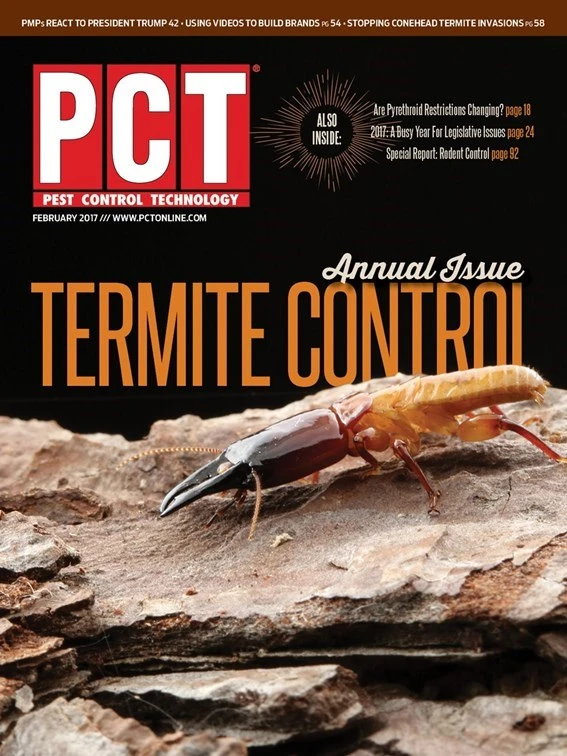
When Michael Wilson, owner of Aardvark Pest Control in Lantana, Fla., decides he is all in on an idea or project, he isn’t kidding.
Why else would this second-generation pest management professional donate his time and talents crawling through Florida’s notoriously dense and unforgiving underbrush with a backpack sprayer to treat for the ultra-aggressive conehead termite?
Wilson is one of a select group of Florida pest management professionals, researchers and state officials determined to eliminate the conehead termite, a particularly nasty species of termite that has emerged in two South Florida communities — Dania Beach and Pompano Beach — infesting nearly 100 structures.
The conehead termite, a species native to the Caribbean and Central and South America, differentiates itself from its subterranean relatives by living above ground, often in plain view. This might give the impression that by its “laissez-faire” approach to being seen makes it an easy pest to eliminate. Think again.

“Conehead termites will eat any type of wood or cellulose product that is available to them — they are not picky,” says Wilson. “But it is their aggressive reproductive capabilities and unusual ability to forage long distances and ‘hitch rides’ that makes them a real threat.”
Wilson says deploying traditional subterranean treatment techniques won’t get the job done with conehead termites because they don’t live in the soil but rather build prodigious exploratory tubes up tree trunks, in ceilings or up the side of telephone poles or structures.
To do the job correctly you have to physically remove the nest and treat the surface underneath it to allow the product to permeate the wood.
“My first encounter with coneheads was in Dania Beach when they infested the entire ceiling of a 20-foot by 45-foot mobile home at a local marina,” says Wilson. “We hadn’t seen anything like it before and we soon learned it was not your typical termite.”
Wilson recalls the colony building exploratory tubes across a highway leading people to believe they were ants — a misdiagnosis that would be costly as several structures had to be condemned because of the extensive damage.
More recently, a second group of conehead termites was found in Pompano Beach — 13 miles from the original infestation in Dania Beach — in a garbage facility when an employee opened a file drawer and discovered it was full of conehead termites eating paper files.

Since 2012, more than 90 properties in the two communities were known to have harbored conehead termites and that number has dropped to four known properties. But Wilson isn’t resting easy.
“This is an aggressive junkyard dog-like termite that is very mobile and that is where the real threat comes in,” says Wilson. “They will expend a lot of energy building exploratory tubes looking for new locations to set up shop and feed.”
WORKING HARD. Dr. Barbara Thorne, a researcher at the University of Maryland and adviser to the Florida Department of Agriculture and Consumer Services’ Conehead Termite Program, says Wilson’s contributions to the conehead termite eradication effort have been significant.
“Michael has been a huge help to our cause, volunteering his time, expertise and equipment during inspections and treatments,” says Thorne. “He has also contributed much to training and education efforts, and to building collaborative relationships with the various groups involved.”
The challenge of removing the conehead termite and preventing them appealed to Wilson’s lifelong desire to learn more about an industry that he grew up in. Wilson’s father, a Korean War veteran, started in the industry with Ace Exterminators and eventually opened Aardvark Pest Control in 1974.
Wilson started teaching CEU classes to Florida PMPs after connecting with the late Mel Edelstein, former executive director of the Certified Pest Control Operators Association of Florida.
“Mel wanted to raise the bar on education for members and the industry, and I ended up teaching classes on termites, general pest control, fumigation and lawn care,” says Wilson. “I enjoyed it and discovered I was actually pretty good at.”
Wilson says education is a two-way street that has allowed him to learn by working with pest management professionals in the field on real-world problems and solutions.
“I have been fortunate to work with so many talented people and learn as much, if not more, than I have given out,” says Wilson.
In Wilson’s opinion the battle against the conehead termite will be won through education of not only pest management professionals but of green industry professionals, utility workers and municipal workers whose work takes them outdoors on a daily basis.
“We are certainly making progress in our treatment methods and expanding the circle with our educational efforts,” says Wilson. “Knowledge of proper identification, biology, behavior and respecting their ability to infest almost anywhere is vital because if you miss one flower pot you could be in trouble.”
Wilson says the industry is moving to have the conehead termite added to termiticide product labels (they are using a special use exemption) and that he and others are working with FDACS and scientists on creating a best management practices guide for the industry.
The author is a communications and marketing consultant with B Communications. He can be reached at jfenner@b-communications.com.
Get curated news on YOUR industry.
Enter your email to receive our newsletters.

Explore the February 2017 Issue
Check out more from this issue and find your next story to read.
Latest from Pest Control Technology
- Termatrac Introduces iTraker Pro
- All-American Pest Control Celebrates Employees at Annual Awards Ceremony
- NEPMA PestVets Unit Collects Food and Clothing Items for Veterans
- When Can a Site Be Declared 'Bed Bug-Free?'
- PestWorld East 2025 Program Announced
- Hygiene IQ Uses Smart Sensor Technology to Detect Rodents
- Rollins Acquires Saela Pest Control
- PCT Spotlights Leaders in Pest Management for Women’s History Month





